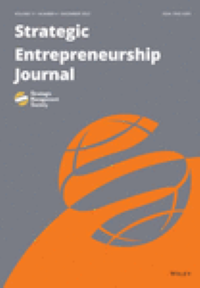保持真实:企业家如何有效披露风险
IF 6.3
2区 管理学
Q1 BUSINESS
引用次数: 0
摘要
研究摘要通过三项研究(N = 300、141、188),我们运用印象管理理论考察了创业者是否以及如何在促进受众有益认知的同时战略性地披露风险。在众筹背景下,我们发现,有意将正面信息与风险披露结合在一起--我们称之为 "补偿 "策略--会提高融资结果。此外,我们还进行了两次后续随机实验(N = 141、188),以检验补偿与众筹绩效之间关系的干预机制(即感知真实性、项目质量)和边界条件(即信息特异性、性别)。我们的研究对战略性风险披露有一定的启示,拓展了我们对影响印象管理策略有效性的背景因素的理解,并为参与众筹的创业者提供了指导。管理总结早期创业者是否应该向潜在投资者披露风险?在我们的研究中,我们探讨了选择披露新企业相关风险的影响。虽然风险披露可能会损害融资努力,但我们发现,使用一种我们称之为 "补偿 "的策略--将风险披露与旨在降低风险的信息打包在一起--可以通过培养对真实性的认知来增强早期创业者的融资努力。此外,我们还发现,这种策略对女性创业者的益处似乎比男性创业者更大。总之,我们的研究表明,创业者应该披露风险,但应注意披露的具体方式。本文章由计算机程序翻译,如有差异,请以英文原文为准。
Keeping it real: How entrepreneurs effectively disclose risk
Research SummaryAcross three studies (N = 300, 141, 188), we apply impression management theory to examine if and how entrepreneurs can strategically disclose risk while facilitating beneficial audience perceptions. In the crowdfunding context, we show that intentionally packaging positive information with risk disclosures—a strategy we describe as “compensation”—enhances financing outcomes. Furthermore, we conducted two follow‐up randomized experiments (N = 141, 188) to test intervening mechanisms (i.e., perceived authenticity, project quality) and boundary conditions (i.e., information specificity, gender) of the relationship between compensation and crowdfunding performance. Our research has implications for the strategic disclosure of risk, extends our understanding of contextual factors that influence the effectiveness of impression management tactics, and provides guidance for entrepreneurs engaged in crowdfunding efforts.Managerial SummaryShould early‐stage entrepreneurs disclose risk to potential investors? In our study, we examine the effects of making the choice to disclose risks associated with a new venture. While risk disclosure may harm financing efforts, we reveal that using a tactic we call “compensation”—in which risk disclosures are packaged with information meant to mitigate the risk—enhances financing efforts for early‐stage entrepreneurs by cultivating perceptions of authenticity. Furthermore, we found that the benefit of this tactic appears to be even greater for female entrepreneurs than male entrepreneurs. Overall, our research shows that entrepreneurs should disclose risk, but should take care to do so in a specific manner.
求助全文
通过发布文献求助,成功后即可免费获取论文全文。
去求助
来源期刊

Strategic Entrepreneurship Journal
Multiple-
CiteScore
11.10
自引率
1.60%
发文量
31
期刊介绍:
The Strategic Entrepreneurship Journal is a research journal that publishes original work recommended by a developmental, double-blind review process conducted by peer scholars. Strategic entrepreneurship involves innovation and subsequent changes which add value to society and which change societal life in ways which have significant, sustainable, and durable consequences. The SEJ is international in scope and acknowledges theory- and evidence-based research conducted and/or applied in all regions of the world. It is devoted to content and quality standards based on scientific method, relevant theory, tested or testable propositions, and appropriate data and evidence, all replicable by others, and all representing original contributions. The SEJ values contributions which lead to improved practice of managing organizations as they deal with the entrepreneurial process involving imagination, insight, invention, and innovation and the inevitable changes and transformations that result and benefit society.
 求助内容:
求助内容: 应助结果提醒方式:
应助结果提醒方式:


